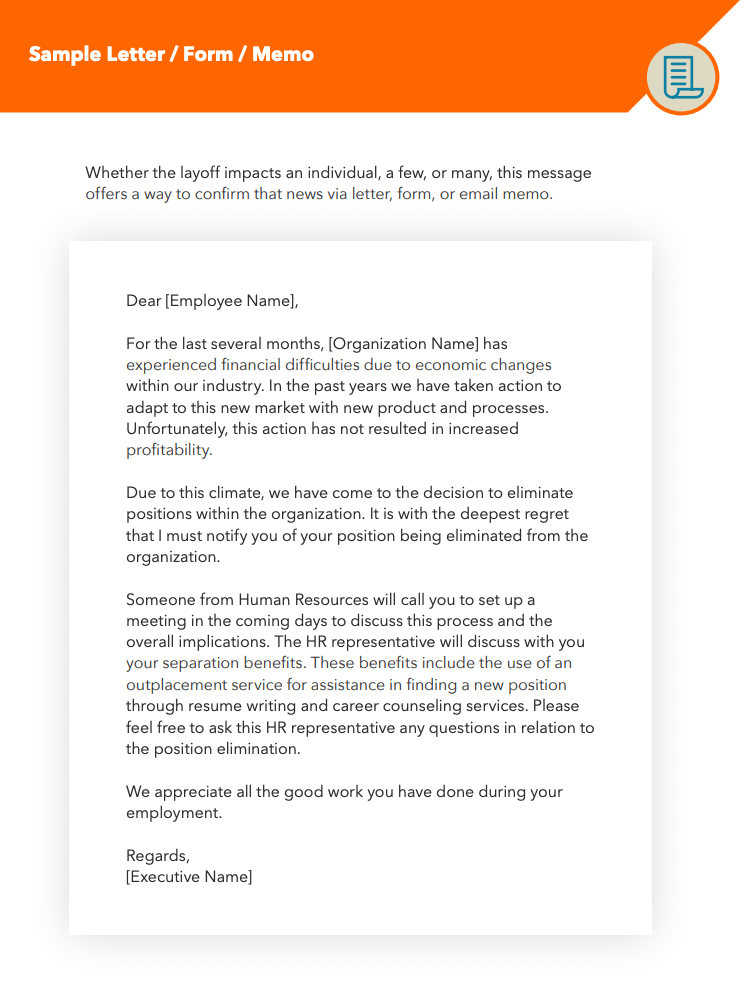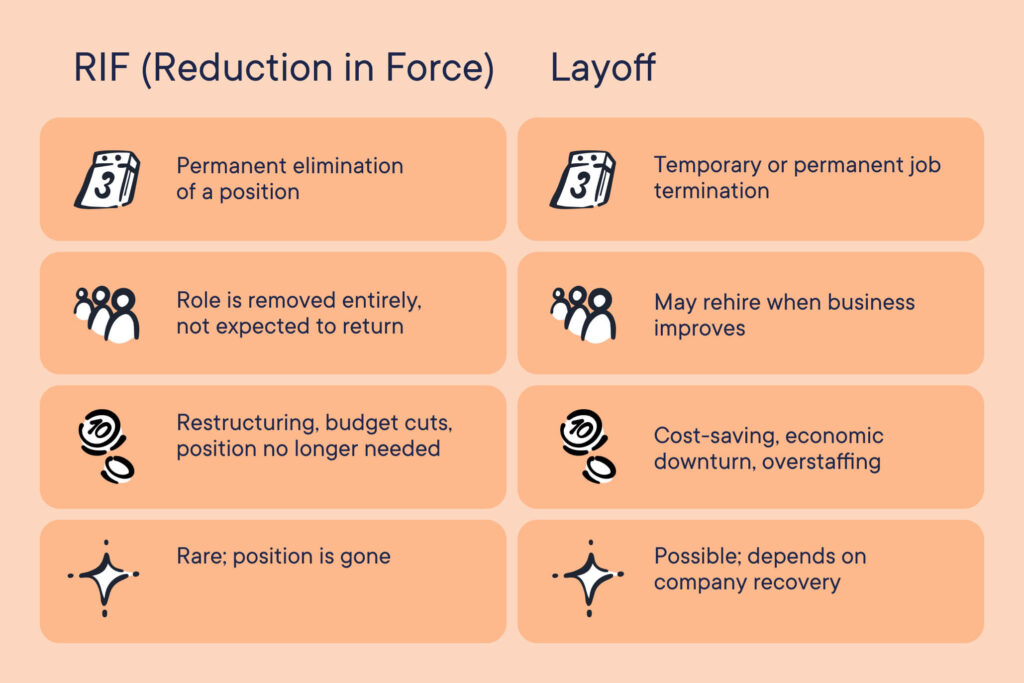
Preparing for a RIF?
Download our Essential Guide to Handling a Layoff
Request Pricing
Compare our rates to other providers
We often see the terms reduction in force (RIF) and layoff being thrown around to describe the same thing: someone losing their job. But no matter how frequently you see these terms being interchanged, they are not the same. This is a common issue that we refer to as the RIF vs. layoff mix-up. How do you differentiate between a RIF and a layoff?
Chances are, you’ve lost your job or stopped working at some point in your working life. At the very least, you know someone who has gone through something like this. How did they break the news to you? Did they use the words layoff or reduction in force? (Sometimes people confuse this with being fired, too, which is an even bigger difference.)
You may be wondering: RIF vs. layoff—what does it matter what you call it? Isn’t it the same thing at the end of the day? Well, not exactly. These terms refer to two distinct kinds of downsizing and weren’t coined just for fun. RIFs and layoffs are, in fact, quite different and should be treated as such.
If you’re looking for resources to help you communicate a RIF or layoff to your employees, click below to download our sample layoff letter with a customizable template that will help ensure professionalism, clarity, and sensitivity during such difficult transitions.

What Is the Difference Between a RIF and a Layoff?
A layoff is an involuntary, often temporary separation of employment due to budgetary or operational reforms. On the other hand, a reduction in force (RIF) is implemented when there is no longer a need for employee positions due to larger restructuring or financial constraints and the termination is permanent from the start.
Let’s look at each of these in more detail.
Layoffs
During layoffs, the organization can’t afford to keep the position open, or the position is temporarily unavailable. However, the good news about these scenarios is that they are not usually permanent. Instead, they are typically temporary.
The main reasons for a layoff are when there isn’t enough work for the employee, or when some other business decision has led to a role being redundant or unneeded at the current time. During a layoff, impacted employees no longer perform work-related duties or receive wages.
Employers who issue layoffs do so temporarily, with the honest intention of recalling employees as soon as business picks up. However, although a layoff is primarily considered a temporary termination of employment, it can become permanent. For example, if the role isn’t ever needed again, then the layoff becomes a RIF after a certain amount of time.

Reductions in Force
Because a reduction in force (RIF) is permanent, the potential to rehire following this kind of event is close to nil. A RIF is usually preceded by a change in business strategy, radical budget reforms, or other drastic issues that cannot be solved with a temporary termination of employment.
Consequently, a layoff differs from a reduction in force because it is primarily considered temporary and has potential for rehiring. In contrast, rehiring or recalling is generally not an option in the case of a reduction in force.
Additionally, it’s important to mention that good planning and organization are pivotal when implementing a RIF or layoff. Everyone within an organization fares better when the termination of employment is handled skillfully. This means employers should develop a workforce reduction strategy to minimize the negative effects associated with the termination of employment.
Regardless of whether it’s temporary or permanent, HR teams should follow reduction-in-force guidelines for easy implementation. Click below to download our comprehensive layoff guide with step-by-step strategies to ensure a smooth transition for your employees while protecting your company’s reputation.
How Should Companies Decide Between a RIF and a Layoff?
As you know, companies decide on workforce reductions due to the need for reorganizing, recovering from financial hurdles, or limiting their operations. More specifically, a reduction in force is usually caused by massive budget cuts, rigorous reorganizations, mergers, or acquisitions, while layoffs result from less critical scenarios, like decreased sales or a temporary reorganization.
When to Choose a RIF
You can say that a RIF is more of a permanent solution to a perpetual problem. For example, if a company discontinues the production, selling, and delivery of a particular product or service, certain positions will become redundant. The same goes for a company that has lost or ended a large contract.
In both instances, a reduction in force is more than appropriate since there is no longer a need for these employees, now or in the foreseeable future. In most cases, RIFs are an obligatory process for businesses in these situations to continue operating and maintain positive cash flow.
When to Choose a Layoff
Layoffs are more of a strategic move than a mandatory business process, potentially providing a temporary solution to decreased revenue or production. For instance, an influx of work during the holiday season may require more employees. But as soon as this busy period passes, there is no need to have the same number of employees. To save money, companies may then implement employee layoffs with the intention of rehiring those individuals later if needed.
However, as mentioned above, a layoff can become permanent. This is most likely why RIFs and layoffs are frequently lumped together. So it’s critical to know the finer details, especially when talking to staff members impacted by the layoff. During their exit interview, you need to explain if this is a permanent termination or if the employee will be on a recall list for a specific period.
Legal Issues with RIFs and Layoffs
Before implementing a RIF or layoff, HR should be aware of legal issues and act accordingly.
- The WARN Act: Organizations with over 100 employees must provide a 60-day WARN notice to employees before plant closings and mass layoffs.
- ADEA: Workforce reductions cannot unfairly target employees over the age of 40.
- COBRA: Employers should provide employees with the proper documentation to set up COBRA, or risk facing a lawsuit.
- FMLA: Things can get tricky when conducting workforce reductions while affected employees are on unpaid leave, such as maternity leave.
- USERRA: This law protects employees who take leave from work to serve in the military, so terminating an employee protected by this law can cause legal trouble.
- Workers’ Compensation: Organizations must provide a valid reason before employee termination that is not due to employee injuries or workers’ compensation claims.
- EEOC: The Equal Employment Opportunity Commission prohibits workplace discrimination against employees in protected classes, including during RIFs and layoffs.
Pay attention to government laws and guidelines to manage a compliant RIF or layoff. This will ensure that you avoid legal trouble during workforce reductions.
RIF vs. Layoff: The Verdict
We can conclude that the main difference between a RIF and a layoff lies in the duration. Namely, the former is permanent, while the latter is typically temporary.
To avoid confusion, HR teams should assert this difference when implementing workforce reductions and refrain from using the terms interchangeably. If you’re preparing for a RIF or layoff, consider the reasons for the termination of employment. Do you see the potential to rehire impacted employees in the near future, or is this a permanent separation?
If you’re not sure, consult with your legal and management teams, as well as your company’s termination policy, so that you know what to expect. You can also click below to connect with our experts and learn how Careerminds can help you navigate the delicate process with our arsenal of guides, templates, and industry-leading outplacement services.
In need of outplacement assistance?
At Careerminds, we care about people first. That’s why we offer personalized talent management solutions for every level at lower costs, globally.



